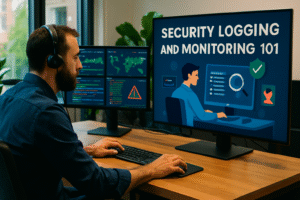
Understanding zero trust architecture
In the rapidly evolving landscape of cybersecurity, the phrase Zero Trust Architecture (ZTA) has shifted from a buzzword to a necessity. As organizations adapt to distributed workforces, cloud computing, and continual digital transformation, the old model of trust—where everything inside a corporate firewall was considered safe—has proven insufficient. Zero Trust, by contrast, assumes that no user, device, or network can be inherently trusted, even if they operate from within the organization’s perimeter.
For educators, technologists, and anyone passionate about the future of secure digital infrastructure, understanding Zero Trust is both an intellectual and practical imperative. This is particularly true for women entering tech and neurodivergent learners, who often bring fresh perspectives and critical questioning to complex topics.
What Is Zero Trust Architecture?
Zero Trust Architecture is a security framework that operates on the principle: “Never trust, always verify.” Traditional security models granted access based on network location—if you were inside the company’s network, you had broad access. Zero Trust flips this on its head. Instead of a trusted internal network and an untrusted external one, everything is treated as potentially hostile. Every request for access is explicitly verified, regardless of its origin.
Zero Trust is not a product or a single solution—it’s a philosophy and a set of guiding principles implemented through a combination of technologies, policies, and practices.
This approach is especially relevant as workforces become increasingly remote and cloud resources proliferate. The old boundaries have dissolved; Zero Trust helps organizations adapt to this new reality.
Key Principles of Zero Trust
Zero Trust Architecture is built on a handful of interlocking principles:
- Continuous verification: Always authenticate and authorize based on all available data points, including user identity, device health, and location.
- Least privilege access: Grant users and devices only the access they need—no more, no less.
- Assume breach: Always operate with the assumption that an attacker is already present somewhere in the environment.
- Micro-segmentation: Divide networks and resources into small, isolated segments to limit potential damage from a breach.
- Visibility and analytics: Monitor activity and analyze patterns to detect and respond to threats in real time.
From Theory to Practice: Actionable Examples
While the concept sounds abstract, Zero Trust Architecture can be implemented through concrete steps and technologies. Here are several actionable examples:
1. Identity and Access Management (IAM)
Implementing strong IAM is at the heart of Zero Trust. This means using multi-factor authentication (MFA) for all users, regardless of their location. It also involves regular reviews of access rights and leveraging identity providers that support robust authentication protocols.
Imagine a university’s internal portal. Instead of a single password granting access to all resources, each login attempt triggers a second factor—perhaps a code sent to the user’s phone or a biometric check.
For neurodivergent users, it’s crucial to design authentication processes that are both secure and accessible. Consider alternative verification methods for users with disabilities—like support for passwordless authentication or easy-to-use authenticators.
2. Device Health Verification
Zero Trust extends beyond user identities to the devices they use. Every device—laptops, smartphones, tablets—must be verified as secure before it is allowed to access sensitive resources.
This can involve enforcing security policies such as:
- Requiring up-to-date antivirus software
- Ensuring operating systems are patched
- Using device certificates to authenticate known hardware
In practice, a school district might restrict access to student data unless a teacher’s laptop passes a security check. If the device is missing critical updates or is running unapproved software, access is denied until the issue is resolved.
3. Micro-Segmentation and Granular Access Controls
Zero Trust encourages breaking up large, flat networks into smaller, more manageable pieces. This is micro-segmentation. Each segment enforces its own access policies and limits lateral movement—so even if an attacker compromises one part of the network, they can’t easily reach others.
For example, consider a company with separate network segments for finance, HR, and engineering. Employees in finance can only access resources in the finance segment. This limits the blast radius if a security incident occurs.
Granular access controls are especially important in educational settings, where sensitive student information must be strictly protected and access must be tailored to staff roles.
4. Continuous Monitoring and Real-Time Response
Zero Trust is not a “set it and forget it” approach. It requires ongoing monitoring and real-time analytics to detect abnormal behavior. Modern solutions employ machine learning to analyze patterns and flag anything unusual—such as a user accessing resources outside of normal hours or from an unusual location.
When an anomaly is detected, automated responses might include:
- Requiring additional authentication
- Temporarily suspending access
- Alerting IT staff for investigation
This kind of vigilance helps catch threats early, before they escalate into major breaches.
Why Zero Trust Matters—Especially Now
We are living in an age where the attack surface is vast and constantly shifting. Cloud adoption, remote education, and collaboration tools have made it easier for people to work and learn anywhere—but have also blurred the boundaries that once defined “inside” and “outside” the network.
Women and underrepresented groups in tech, including neurodivergent professionals, are increasingly joining cybersecurity and IT teams. Their perspectives are vital. Zero Trust, with its demand for constant questioning and critical analysis, aligns well with the strengths of those who naturally challenge assumptions and seek structural clarity.
Zero Trust is not about paranoia; it’s about resilience. It’s a recognition that trust must be earned and continuously validated, not assumed.
Addressing Challenges and Misconceptions
Despite its benefits, some organizations find Zero Trust daunting. Common concerns include:
- Complexity: Zero Trust requires careful planning and often a cultural shift in how teams think about security.
- Cost: Implementing new technologies and processes can be resource-intensive, especially for smaller organizations.
- User Experience: Extra authentication steps can add friction if not thoughtfully designed.
However, these challenges are not insurmountable. Start with a pilot project—perhaps focusing on a high-risk application or department—and iterate from there. Involve users in the design process to ensure accessibility and inclusivity, especially for those who may find traditional security tools unintuitive or difficult to use.
Tips for Implementing Zero Trust in Education and Tech Organizations
Moving toward Zero Trust does not require an all-or-nothing approach. Here are practical steps you can take to begin the journey:
1. Map Your Assets and Data Flows
Before you can protect resources, you need to know what you have and how it’s used. Create an inventory of devices, applications, and data repositories. Map how information flows between users and systems. This foundational step is especially helpful for neurodivergent learners, who often excel at pattern recognition and systems thinking.
2. Prioritize High-Value Targets
Focus initial Zero Trust efforts on the most critical assets—such as personal data, financial systems, or proprietary research. Apply strict access controls and monitoring here first. This staged approach helps build momentum and demonstrates early wins.
3. Foster a Culture of Security Awareness
Zero Trust is as much about people as it is about technology. Provide regular training tailored to different learning styles and abilities. Use clear, jargon-free language, and emphasize the “why” behind security measures. Encourage staff and students to report suspicious activity and ask questions. Neurodivergent individuals often spot inconsistencies others miss—empower them to contribute.
4. Leverage Modern Security Tools
Adopt technologies that support Zero Trust principles:
- Single sign-on (SSO): Simplifies authentication across multiple services while maintaining strong security.
- Endpoint detection and response (EDR): Provides real-time monitoring and automated threat mitigation on devices.
- Cloud access security brokers (CASB): Enforce policies on cloud services and monitor usage patterns.
Choose tools with built-in accessibility features to ensure everyone, regardless of ability, can use them effectively.
5. Iterate and Improve
Zero Trust is not a destination; it’s an ongoing process. Regularly review policies, update controls, and incorporate feedback from users. As threats evolve, so too must your defenses.
Zero Trust and the Future of Work and Learning
The principles of Zero Trust are not limited to large enterprises or high-security environments. Schools, universities, non-profits, and startups can all benefit from adopting its mindset. By designing for continuous verification, least privilege, and real-time monitoring, organizations create safer spaces for creativity, collaboration, and learning.
Crucially, Zero Trust aligns with broader movements toward inclusivity in tech. It values diverse perspectives and recognizes that trust is not a given, but a process. For women in IT and neurodivergent professionals, this framework provides both a technical foundation and an invitation to challenge the status quo.
In a world where threats are unpredictable and ever-changing, Zero Trust offers a path forward—not just for security, but for building resilient, adaptive, and equitable digital communities.
For those beginning their journey, remember: small, consistent steps yield the greatest progress. Foster collaboration, welcome diverse insights, and keep questioning assumptions. The future of security—and of technology itself—belongs to those who build it thoughtfully and inclusively.


